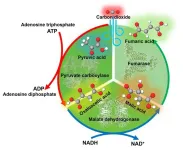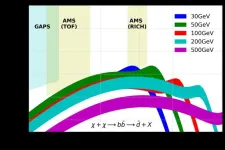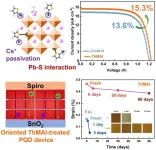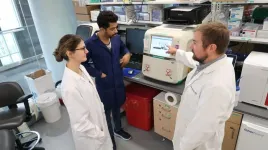Improving fumaric acid production efficiency through a ‘more haste, less speed’ strategy
Future of bioplastics made from carbon dioxide and biomass molecules could rely on more enzymes, shorter incubation periods
2024-10-04
(Press-News.org)
As plastic waste continues to build up faster than it can decompose, the need for biodegradable solutions is evident.
Previously, Professor Yutaka Amao and his team at Osaka Metropolitan University’s Research Center for Artificial Photosynthesis succeeded in synthesizing fumaric acid, a raw material for biodegradable plastics from biomass-derived pyruvic acid and carbon dioxide. However, the fumaric acid production process reported earlier has a problem with producing undesirable substances as byproducts in addition to L-malic acid, which is required as an intermediate.
Continuing this research, the team devised a “more haste, less speed” strategy that supplements the two reactions performed by a single malate dehydrogenase decarboxylase with two different enzymes. Based on this strategy, it is predicted that an efficient fumaric acid production system could be developed from bio-based pyruvate material and carbon dioxide.
As a result, the team succeeded in converting approximately 80% of the pyruvic acid into L-malic acid in 5 hours of incubation, compared to the previous result of approximately 46% conversion in 7 hours. Furthermore, by adding fumarase to this reaction system, the efficiency of converting the pyruvic acid to fumaric acid was improved from the conventional 10% to about 16% in 5 hours of incubation.
“In the conventional fumaric acid production system, only pure carbon dioxide gas could be used, but this research has revealed the possibility of using low-concentration carbon dioxide gas emitted from thermal power plants and steel mills,” stated Professor Amao. “In addition, we have also started to develop a system for producing fumaric acid using light energy as an application of artificial photosynthesis technology.”
The findings were published in RSC Sustainability.
###
About OMU
Established in Osaka as one of the largest public universities in Japan, Osaka Metropolitan University is committed to shaping the future of society through “Convergence of Knowledge” and the promotion of world-class research. For more research news, visit https://www.omu.ac.jp/en/ and follow us on social media: X, Facebook, Instagram, LinkedIn.
END
ELSE PRESS RELEASES FROM THIS DATE:
2024-10-04
The oceans are warming at an alarming rate. 2023 shattered records across the world’s oceans, and was the first time that ocean temperatures exceeded 1oC over pre-industrial levels. This led to the emergence of a series of marine heatwave events across both hemispheres, from the waters around Japan, around South America, and across the wider North Atlantic. Marine heatwaves are periods of extremely warm sea temperatures that can form in quite localized hot spots but also span large parts of ocean ...
2024-10-04
One of the great challenges of modern cosmology is to reveal the nature of dark matter. We know it exists (it constitutes over 85% of the matter in the Universe), but we have never seen it directly and still do not know what it is. A new study published in JCAP has examined traces of antimatter in the cosmos that could reveal a new class of never-before-observed particles, called WIMP (Weakly Interacting Massive Particles), which could make up dark matter. The study suggests that some recent observations ...
2024-10-04
Nearly three out of four kids in Chicago had no swimming lessons in summer of 2022, with significant racial and ethnic differences, according to a parent survey from Ann & Robert H. Lurie Children’s Hospital of Chicago published in Pediatrics. Black and Hispanic/Latine kids were disproportionately affected (85 percent and 82 percent, respectively), compared to white kids (64 percent).
The most common reasons for not getting swimming lessons also differed among racial and ethnic groups. Parents of White kids reported they ...
2024-10-04
□ Professor Jongmin Choi’s team from the Department of Energy Science and Engineering at DGIST (President Kunwoo Lee) conducted joint research with Materials Engineering and Convergence Technology Professor Tae Kyung Lee from Gyeongsang National University and Applied Chemistry Professor Younghoon Kim from Kookmin University. The researchers developed a new method to improve both the performance and the stability of solar cells using “perovskite quantum dots.” They developed longer-lasting solar cells by addressing the issue of distortions on the surface of quantum dots, which deteriorate the ...
2024-10-04
Rehearsing alternative outcomes of discarding through imagery rescripting shows promise as a treatment strategy for people who hoard, a study by UNSW psychology researchers has shown.
Hoarding disorder is a highly debilitating condition that worsens with age. People who hoard form intense emotional attachments to objects, accumulate excessive clutter, and have difficulty discarding possessions. Many avoid treatment.
People who hoard also experience more frequent, intrusive and distressing mental images in their daily lives, says Mr Isaac Sabel from the Grisham Research Lab, an experimental clinical psychology research group at UNSW Sydney.
“Negative ...
2024-10-04
The dental health benefits of adding fluoride to drinking water may be smaller now than before fluoride toothpaste was widely available, an updated Cochrane review has found.
The team of researchers from the Universities of Manchester, Dundee and Aberdeen reviewed the evidence from 157 studies which compared communities that had fluoride added to their water supplies with communities that had no additional fluoride in their water. They found that the benefit of fluoridation has declined since the 1970s, when fluoride toothpaste became more widely available.
The contemporary studies were conducted in high-income countries. The impact of community water fluoridation ...
2024-10-04
Toddlers in the UK obtain nearly half (47%) of their calories from ultra-processed foods (UPFs), and this rises to 59% by the age of seven, according to a new study led by UCL researchers.
The study, published in the European Journal of Nutrition, looked at data from 2,591 children born in the UK in 2007 and 2008 whose parents recorded what their children ate and drank over three days.
The most common UPFs consumed by the toddlers – who were 21 months when their parents recorded their diets – were flavoured ...
2024-10-03
DETROIT — A new grant will help Wayne State University researchers explore the links between bacterial infections, the environmental factors that increase their susceptibility and the risk of preterm birth.
The five-year, $2,858,821 grant from the National Institute of Environmental Health Sciences of the National Institutes of Health, “PFAS increases susceptibility to infection-mediated preterm birth,” will be led by Michael Petriello, Ph.D., assistant professor in Wayne State’s Institute of Environmental Health Sciences and Pharmacology in the School of Medicine.
Petriello hopes that the team’s studies will identify critical pathways responsible ...
2024-10-03
Highlights:
Antimicrobial resistance is a growing threat.
Bacteria exchange AMR genes in the gut via circular genetic material called plasmids.
In lab experiments, bacteria transferred plasmids with AMR genes in the presence of zinc at reduced or nonexistent rates.
Stopping the transfer without killing microbes may help reduce AMR without disrupting the gut microbiome.
Washington, D.C.—Genes responsible for antimicrobial resistance (AMR) can spread from microbe to microbe through circular genetic material called plasmids, and ...
2024-10-03
On October 3, 2024, NASA announced that two space probes proposed by University of Maryland astronomers have advanced to the next round of consideration for a $1 billion mission slated to launch into orbit in 2032.
The selected probes include the Advanced X-ray Imaging Satellite (AXIS) mission with UMD Astronomy Professor Christopher Reynolds as its principal investigator and the PRobe far-Infrared Mission for Astrophysics (PRIMA) with UMD Astronomy Professor Alberto Bolatto as a co-investigator and NASA Goddard Space Flight Center researcher and UMD Astronomy ...
LAST 30 PRESS RELEASES:
[Press-News.org] Improving fumaric acid production efficiency through a ‘more haste, less speed’ strategy
Future of bioplastics made from carbon dioxide and biomass molecules could rely on more enzymes, shorter incubation periods






